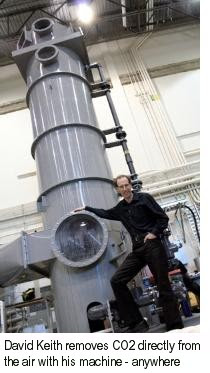 Professor David Keith of the University of Calgary is working on a device that removes carbon dioxide directly from ambient air.
Professor David Keith of the University of Calgary is working on a device that removes carbon dioxide directly from ambient air.Keith has built a tower, 4 feet wide and 20 feet tall, with a fan at the bottom that sucks air in. Keith expects the air coming out at the top to have approximately 50% less carbon dioxide than the air coming in.
The tower features in an episode of Discovery Channel’s new “Project Earth” series on TV. The series has the largest budget of any in Discovery Channel’s history, and it may eventually attract a global viewership of more than 100 million.
The episode on Keith’s research has already aired in the U.S. - if you're missed it, you can watch it on Discovery Channel’s website, at: http://dsc.discovery.com/tv/project-earth/project-earth.html - click on “Episodes.”
If the program hasn't aired in your country, you may not get access to the online episode, but you can read more at: http://dsc.discovery.com/tv/project-earth/lab-books/fixing-carbon/guide1.html - also click on the links under "MORE CARBON".
The picture below describes the Big Picture of recycling, in which I envisage aviation to fund CO2 air capture. When talking about recycling, most people think about recycling of industrial products only. They may also see composting of organic waste as a (second) way of recycling. Instead of composting, I actually envisage organic waste to be burned by means of pyrolysis, in order to produce agrichar and hydrogen. I also envisage a third way of recycling that includes removing CO2 from the air. This CO2 could also be used for the production of agrichar and for commercial purposes such as to enrich greenhouses and for the production of building material, carbon fiber, etc. Furthermore, this CO2 could be used as fuel for aviation.
To tackle emissions by aviation, we can switch to airplanes and helicopters that are powered by batteries and hydrogen, or switch to fuels other than fossil fuel. Growth of algae could be assisted by such captured CO2, which could also be turned directly into fuel.
By financially supporting air capture of CO2 and the use of such CO2 to produce fuel, aviation could close the circle of this third way of recycling. This could make aviation environmentally sustainable. Since government is such a large user of aviation (both the military and civil parts of government), it makes sense for the government to start funding such air capture as soon as possible. An international agreement, to be reached in Copenhagen in 2009, could further arrange for the proceeds of environmental fees on commercial flights to fund such air capture and its use for fuel.
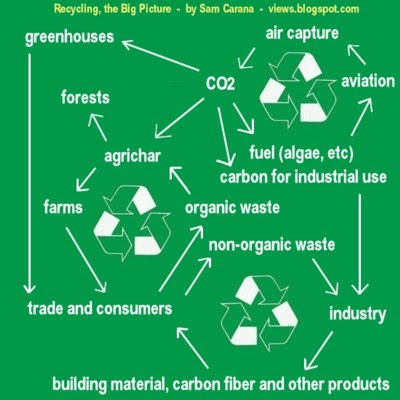
Further links:
http://dsc.discovery.com/tv/project-earth/explores/carbon.html - Discovery Channel
http://www.ucalgary.ca/news/september2008/keith-carboncapture - David Keith
http://www.ucalgary.ca/~keith/AirCapture.html - David Keith
http://www.ucalgary.ca/~keith/Misc/AC%20talk%20MIT%20Sept%202008.pdf - M.I.T.
views.blogspot.com - by Sam Carana
The post below is added for archival purposes. It was originally posted by Sam Carana at knol in 2009, which has meanwhile been discontinued by Google. The post received 4513 views at knol.
Funding of Carbon Air Capture
HOW CAN CO2 CAPTURE FROM AMBIENT AIR BEST BE FUNDED?
FEES ON JET FUEL CAN HELP FUND THE DEVELOPMENT OF CARBON CAPTURE FROM AMBIENT AIR.
 AIR CAPTURE of CO2 (carbon dioxide) is an essential part of the blueprint to reduce carbon dioxide to acceptable levels. Fees on
AIR CAPTURE of CO2 (carbon dioxide) is an essential part of the blueprint to reduce carbon dioxide to acceptable levels. Fees on  conventional jet fuel seems the most appropriate way to raise funding to help with the development of air capture technology.
conventional jet fuel seems the most appropriate way to raise funding to help with the development of air capture technology.Why target jet fuel? In most other industries, there are ready alternatives to the use of fossil fuel. Electricity can be produced by wind turbines or by solar or geothermal facilities with little or no emissions of greenhouse gases. In the case of aviation, though, the best we can aim for, in the near future at least, is biofuel or synthetic fuel, produced from CO2 captured from ambient air. As discussed below, development of these two forms of renewable energy can go hand in hand.
Carbon air capture and production of synthetic fuel and bio fuel can go hand in hand
Technically, there seems to be no problem in powering aircraft with bio fuel. Back in Jan 7, 2009, a Continental Airlines commercial aircraft (a Boeing 737-800) was powered in part by algae oil, supplied by Sapphire Energy. The main hurdle appears to be that algae oil is not perceived as price-competitive with fossil fuel-based jet fuel.
Additionally, the aviation industry can offset emissions, e.g. by funding air capture of carbon dioxide. The carbon dioxide thus captured could be partly used to produce fuel, which could in turn be used by the aviation industry, as pictured on the top right image. The carbon dioxide could also be used to assist growth of biofuel, e.g. in greenhouses and in algae bags, as described below.
Additionally, the aviation industry can offset emissions, e.g. by funding air capture of carbon dioxide. The carbon dioxide thus captured could be partly used to produce fuel, which could in turn be used by the aviation industry, as pictured on the top right image. The carbon dioxide could also be used to assist growth of biofuel, e.g. in greenhouses and in algae bags, as described below.
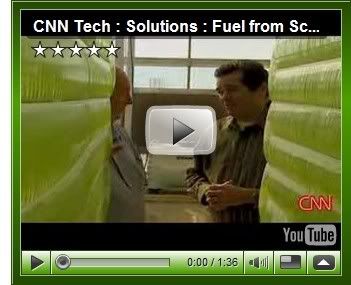 Algae can grow 20 to 30 times faster than food crops. As the CNN video on the right mentions, Vertigro claims to be able to grow 100,000 gallons of algae oil per acre per year by growing algae in clear plastic bags suspended vertically in a greenhouse. Given the right temperature and sufficient supply of light, water and nutrients, algae seem able to supply an almost limitless amount of biofuel.
Algae can grow 20 to 30 times faster than food crops. As the CNN video on the right mentions, Vertigro claims to be able to grow 100,000 gallons of algae oil per acre per year by growing algae in clear plastic bags suspended vertically in a greenhouse. Given the right temperature and sufficient supply of light, water and nutrients, algae seem able to supply an almost limitless amount of biofuel.
The potential of algae has been known for decades. As another CNN report describes, the U.S. Department of Energy (DoE) had a program for nearly two decades, to study the potential of algae as a renewable fuel. The program was run by the DoE's National Renewable Energy Laboratory (NREL) and was terminated by 1996. At that time, a NREL report concluded that an area around the size of the U.S. state of Maryland could cultivate algae to produce enough biofuel to satisfy the entire transportation needs of the U.S.
 Apart from growing algae in greenhouses, we should also consider growing them in bags. NASA scientists are proposing algae bags as a way to produce renewable energy that does not compete with agriculture for land or fresh water. It uses algae to produce biofuel from sewage, using nutrients from waste water that would otherwise be dumped and contribute to pollution and dead zones in the sea.
Apart from growing algae in greenhouses, we should also consider growing them in bags. NASA scientists are proposing algae bags as a way to produce renewable energy that does not compete with agriculture for land or fresh water. It uses algae to produce biofuel from sewage, using nutrients from waste water that would otherwise be dumped and contribute to pollution and dead zones in the sea.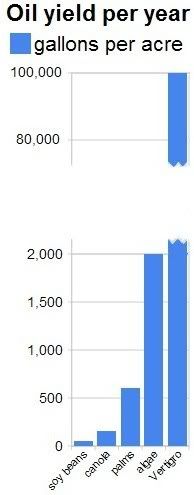 The NASA article conservatively mentions that some types of algae can produce over 2,000 gallons of oil per acre per year. In fact, most of the oil we are now getting out of the ground comes from algae that lived millions of years ago. Algae still are the best source of oil we know.
The NASA article conservatively mentions that some types of algae can produce over 2,000 gallons of oil per acre per year. In fact, most of the oil we are now getting out of the ground comes from algae that lived millions of years ago. Algae still are the best source of oil we know.In the NASA proposal, there's no need for land, water, fertilizers and other nutrients. As the NASA article describes, the bags are made of inexpensive plastic. The infrastructure to pump sewage to the sea is already in place. Economically, the proposal looks sound, even before taking into account environmental benefits.
Jonathan Trent, lead research scientist on the Spaceship Earth project at NASA Ames Research Center, Moffett Field, California, envisages large plastic bags floating on the ocean. The bags are filled with sewage on which the algae feed. The transparent bags collect sunlight that is used by the algae to produce oxygen by means of photosynthesis. The ocean water helps maintain the temperature inside the bags at acceptable levels, while the ocean's waves also keep the system mixed and active.
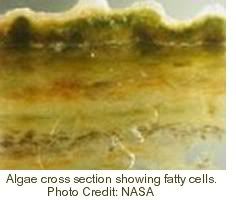 The bags will be made of “forward-osmosis membranes”, i.e. semi-permeable membranes that allow fresh water to flow out into the ocean, while preventing salt from entering and diluting the fresh water inside the bag. Making the water run one way will retain the algae and nutrients inside the bags. Through osmosis, the bags will also absorb carbon dioxide from the air, while releasing oxygen. NASA is testing these membranes for recycling dirty water on future long-duration space missions.
The bags will be made of “forward-osmosis membranes”, i.e. semi-permeable membranes that allow fresh water to flow out into the ocean, while preventing salt from entering and diluting the fresh water inside the bag. Making the water run one way will retain the algae and nutrients inside the bags. Through osmosis, the bags will also absorb carbon dioxide from the air, while releasing oxygen. NASA is testing these membranes for recycling dirty water on future long-duration space missions.As the sewage is processed, the algae grow rich, fatty cells that are loaded with oil. The oil can be harvested and used, e.g., to power airplanes.
In case a bag breaks, it won’t contaminate the local environment, i.e. leakage won't cause any worse pollution than when sewage is directly dumped into the ocean, as happens now. Exposed to salt, the fresh water algae will quickly die in the ocean.
The bags are expected to last two years, and will be recycled afterwards. The plastic material may be used as plastic mulch, or possibly as a solid amendment in fields to retain moisture.
 A 2007 Bloomberg report estimated that the Gulf of Mexico's Dead Zone would reach more than half the size of Maryland that year and stretch into waters off Texas. The Dead Zone endangers a $2.6 billion-a-year fishing industry. The number of shrimp fishermen licensed in Louisiana has declined 40% since 2001. Meanwhile, U.S. farmers in the 2007 spring planted the most acreage with corn since 1944, due to demand for ethanol. As the report further describes, the Dead Zone is fueled by nitrogen and other nutrients pouring into the Gulf of Mexico, and corn in particular contributes to this as it uses more nitrogen-based fertilizer than crops such as soybeans.
A 2007 Bloomberg report estimated that the Gulf of Mexico's Dead Zone would reach more than half the size of Maryland that year and stretch into waters off Texas. The Dead Zone endangers a $2.6 billion-a-year fishing industry. The number of shrimp fishermen licensed in Louisiana has declined 40% since 2001. Meanwhile, U.S. farmers in the 2007 spring planted the most acreage with corn since 1944, due to demand for ethanol. As the report further describes, the Dead Zone is fueled by nitrogen and other nutrients pouring into the Gulf of Mexico, and corn in particular contributes to this as it uses more nitrogen-based fertilizer than crops such as soybeans.
The Louisiana coast seems like a good place to start growing algae in bags floating in the sea, filled with sewage that would otherwise be dumped there. It does seem a much better way to produce biofuel than by subsidizing corn ethanol.
Not Millions, but Billions of Dollars!
Carbon air capture could produce a form of renewable synthetic fuel that could be used to power aviation. Carbon air capture could also help produce biofuel to power aviation. It would therefore make sense to encourage development in carbon air capture by imposing fees on conventional jet fuel and by using the proceeds of those fees to help fund air capture of carbon dioxide.
According to zFacts.com, corn ethanol subsidies totaled $7.0 billion in 2006 for 4.9 billion gallons of ethanol. That's $1.45 per gallon of ethanol (or $2.21 per gallon of gas replaced). As zFacts.com explains, besides failing to help with greenhouse gases and having serious environmental problems, corn ethanol subsidies are very expensive, and the political backlash in the next few years, as production and subsidies double, will damage the effort to curb global warming.
On 15 May, 2009, U.S. Secretary of Energy Steven Chu announced that $2.4 billion from the American Recovery and Reinvestment Act will be used to expand and accelerate the commercial deployment of carbon capture and storage (CCS) technology.
At UN climate talks in Bonn, the world's poorest nations proposed a levy of about $6 on every flight to help them adapt to climate change. Benito Müller, environment director of the Oxford Institute for Energy Studies and author of the proposal, said that air freight was deliberately not included. The levy could raise up to $10 billion per year and would increase the average price of an international long-haul fare by less than 1% for standard class passengers, but up to $62 for people traveling first class.
In the light of those amounts, it doesn't seem unreasonable to expect that fees imposed on conventional jet fuel could raise billions per year. Proceeds could then be used to fund rebates on air capture of carbon dioxide, which could be pumped into the bags on location to enhance algae growth. Air capture devices could be powered by surplus energy from offshore wind turbines. With the help of such funding, the entire infrastructure could be set up quickly, helping the environment, creating job opportunities, making the US less dependent on oil imports, while leaving us with more land and water to grow food, resulting in lower food prices.
Cost of Carbon Air Capture
As to the cost of carbon air capture, GRT puts the current cost to harvest one ton of CO2 at $200 andestimates that, 2-3 years from now, it will cost about $150, while the price will come down to $30 to $20 as the technology is fully mature.
Currently, carbon air capture isn't more expensive than to capture CO2 from smokestacks. The coal industry wants politicians to subsidize "clean coal", but current cost of capture (i.e. excluding transport and storage) is estimated at $100-150/tCO2 initially, possibly reducing to one third of that as the technology matures. That would price coal out of the market, while it doesn't even cover the cost of transporting the CO2 away from the plant and the subsequent sequestration, policing and monitoring all this over many years, etc.
Carbon air capture can be done at off-peak hours when cost of electricity needed for capture is low. Carbon capture from ambient air can also be done anywhere, meaning that it can take place on location, i.e. where the carbon is to be sequestered, which would save on the cost of transport. Or, even better, carbon capture can take place where the carbon is to be used for industrial or agricultural purposes, such as in greenhouses, algae bags or as soil supplements. By mixing carbon with hydrogen, the carbon can also be used to produce carbohydrates, i.e. synthetic fuel that could be used to power shipping and aviation. Such usage can help pay for the cost of carbon air capture.
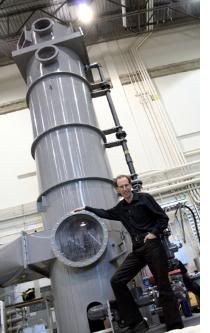 Professor David Keith (left) of the University of Calgary is working on a tower, 4 feet wide and 20 feet tall, with a fan at the bottom that sucks air in. The tower looks like it's made mainly of plastic, which could be made with carbon produced by such a tower. Inside the tower, limestone or a similar agent is used to bind the CO2 and to split CO2 off by heating it up. The limestone is recycled within the tower, although it does need to be resupplied at some stage. Anyway, the main cost appears to be the electricity to run it. Keith and his team showed they could capture CO2 directly from the air with less than 100 kilowatt-hours of electricity per ton of CO2. At $0.10/kWh, that would put the electricity cost at $10 per ton.
Professor David Keith (left) of the University of Calgary is working on a tower, 4 feet wide and 20 feet tall, with a fan at the bottom that sucks air in. The tower looks like it's made mainly of plastic, which could be made with carbon produced by such a tower. Inside the tower, limestone or a similar agent is used to bind the CO2 and to split CO2 off by heating it up. The limestone is recycled within the tower, although it does need to be resupplied at some stage. Anyway, the main cost appears to be the electricity to run it. Keith and his team showed they could capture CO2 directly from the air with less than 100 kilowatt-hours of electricity per ton of CO2. At $0.10/kWh, that would put the electricity cost at $10 per ton.
In the U.S., each person emits about 20 tons of CO2 annually. In other words, each person in the U.S. could remove as much CO2 from the air with such a device, with annual operational costs of $200 for 2 Megawatt-hours of electricity. By comparison, a refrigerator consumes about 1.2 Megawatt-hours annually [2001 figures]. Of course, the additional cost of carbon disposal will make it more attractive to use large facilities at places where there's demand for carbon and where the associated economies of scale would facilitate lower operational costs.
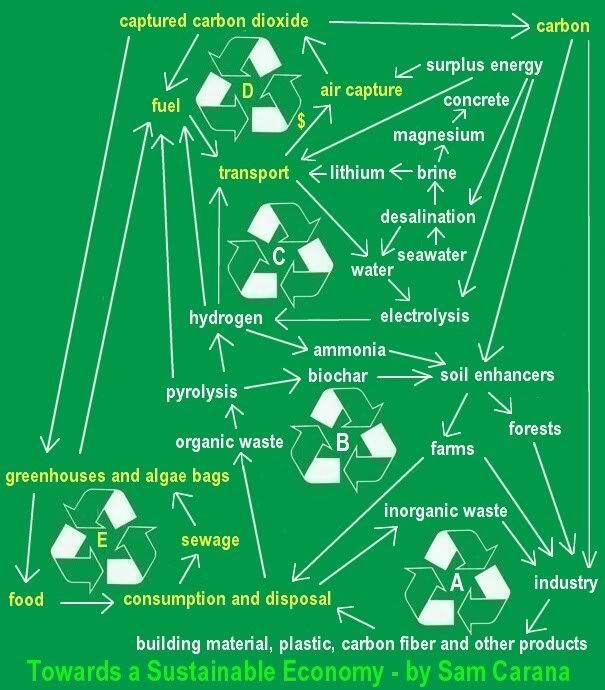
The following comments were posted by Sam Carana under this knol:
Jul 19, 2010
There are several efforts under development to produce a carbon-neutral fuel. Two of them were recently described in article in New Scientist, entitled: Green machine: Cars could run on sunlight and CO2.
http://www.newscientist.com/article/dn18993-green-machine-cars-could-run-on-sunlight-and-co2.html
See also Sandia
https://share.sandia.gov/news/resources/releases/2007/sunshine.html
Whereas many may think that this is a good way to power cars, I agree with you that it makes more sense to have electric cars. However, aviation is a bit more difficult to clean up, that's why aviation in particular can benefit from such technology, and that would justify that aviation made financial contributions to fund such developments.
As air capture technology matures with financial assistance funded by fees on aviation, it will be in a better position to develop into a more general technology used to reduce CO2 in the atmosphere to more acceptable levels.
In my above reply, I referred to the use of concentrating solar power (CSP) plants to produce temperatures high enough to split water vapor into hydrogen and oxygen, and ambient carbon dioxide into carbon monoxide and oxygen. A team led by Athanasios Konstandopoulos has successfully managed to also split carbon dioxide into carbon monoxide and oxygen in this way. The hydrogen and carbon monoxide can subsequently be combined into hydrocarbons, i.e. synthetic oil.
http://www.newscientist.com/article/dn19308-the-next-best-thing-to-oil.html
Aug 27, 2010 http://www.newscientist.com/article/dn19308-the-next-best-thing-to-oil.html
An article in Nature describes the use of a solar cavity-receiver reactor to heat up non-stoichiometric cerium oxide to a temperature at over 1,500 °C, forcing the release of oxygen. Then, to re-oxidize it with H2O and CO2 at below 900 °C to produce H2 and CO – known as syngas, the precursor of liquid hydrocarbon fuels.
http://www.sciencemag.org/content/330/6012/1797
http://www.sciencemag.org/content/330/6012/1797
Jan 28, 2011
Milking algae
Instead of harvesting algae for processing into biofuel, there is prospect for "milking" the algae, i.e. extracting oil from the algae without killing them.
This method is followed by Joule Unlimited.
http://www.theglobeandmail.com/news/opinions/opinion/a-brave-new-world-of-fossil-fuels-on-demand/article1871149/
And also by Algenol, Synthetic Genomics (Craig Venter’s venture) and BioCee
http://theenergycollective.com/tyhamilton/50300/joule-cool-not-alone-quest-sunlight-fuel-game-changer
Jul 5, 2011
British company set to make renewable jetfuel
British company Air Fuel Synthesis plans to capture carbon dioxide from the air, and mix it with hydrogen extracted from water through electrolysis, in order to make liquid hydrocarbon fuels for transport, including for aviation.
http://www.airfuelsynthesis.com/technology.html
http://www.airfuelsynthesis.com/technology/technical-review.html
http://www.airfuelsynthesis.com/faqs.html
Milking algae
Instead of harvesting algae for processing into biofuel, there is prospect for "milking" the algae, i.e. extracting oil from the algae without killing them.
This method is followed by Joule Unlimited.
http://www.theglobeandmail.com/news/opinions/opinion/a-brave-new-world-of-fossil-fuels-on-demand/article1871149/
And also by Algenol, Synthetic Genomics (Craig Venter’s venture) and BioCee
http://theenergycollective.com/tyhamilton/50300/joule-cool-not-alone-quest-sunlight-fuel-game-changer
Jul 5, 2011
British company set to make renewable jetfuel
British company Air Fuel Synthesis plans to capture carbon dioxide from the air, and mix it with hydrogen extracted from water through electrolysis, in order to make liquid hydrocarbon fuels for transport, including for aviation.
http://www.airfuelsynthesis.com/technology.html
http://www.airfuelsynthesis.com/technology/technical-review.html
http://www.airfuelsynthesis.com/faqs.html